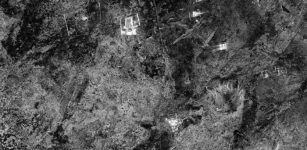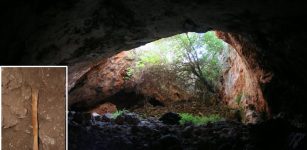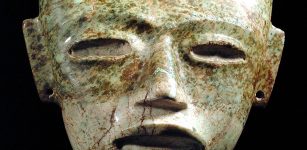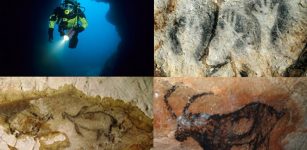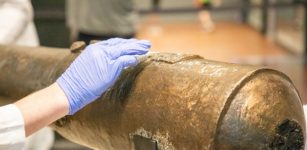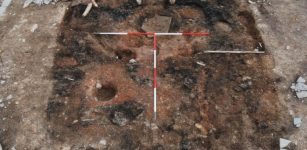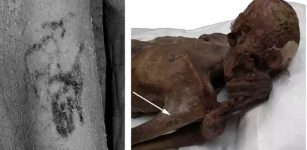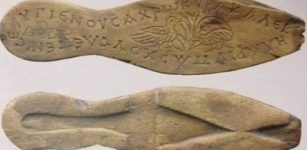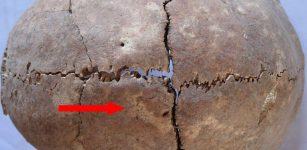8,000 Year-Old Human Skeleton Discovered By Cave Divers Near Tulum, Mexico
Conny Waters - AncientPages.com - A human skeleton that is believed to be over 8,000 years old has been discovered by speleologist and archaeologist Octavio del Río and diver Peter Broger, involved in a diving expedition in the Tulum area, Mexico.
The discovery was accidentally made in an underwater cave system that was flooded at the end of the last ice age, 8,000 years ago.
The skeleton was found in pieces by a diver in a cave in the Tulum area. Based on its location, it's likely to be between 8,000 and nearly 14,000 years old. Screen Capture/SocialMedia via Mexico News Daily.
The cave is ”partly covered by sediment in a cave near where the Mexican government plans to build a high-speed tourist train through the jungle,” said Octavio del Río, as cited by AP.
The skeleton, including the shattered skull, is broken into small pieces, del Río said.
“Because of where it was found [and] the depth, it could only have arrived there when the cave was dry. This was at least 8,000 years ago.”
Given the distance from the cave entrance, the skeleton couldn’t have gotten there without modern diving equipment, so it must be over 8,000 years old, Del Rio said, referring to the era when rising sea levels flooded the caves. He said it was unclear whether the body was deposited in the cave after death or whether the person died where the skeleton was found. In an interview with the Reforma newspaper, del Río said that the gender of the person is also unknown.
“We don’t yet know the sex or the size [of the person], how much he or she weighed, whether the person had a disease. We don’t know how he or she died,” he said.
Del Río said that laboratory analysis would determine such details after the remains have been removed from the cave. “A long study that could last months or years starts now,” he said.
In this photo courtesy of Octavio del Rio, shows fragments of a pre-historic human skeleton partly covered by sediment in an underwater cave in Tulum, Mexico, Sept. 10, 2022. The cave system was flooded at the end of the last ice age 8,000 years ago, according to an archaeologist and cave diver Octavio del Rio, and is located near where the government plans to build a high-speed tourist train through the jungle. (Octavio del Rio via AP)
However, the archaeologist has not revealed the exact location of the cave where the skeleton was found but said in a post to his personal Facebook account that it’s in the Tulum area.
The recent discovery is closely related to ten other discoveries of ancient human remains in the area of Tulum.
“They date from the origin of man in America, with a chronology that ranges from 13,700 years ago to 8,000 years ago,” del Río wrote. “The caves were their homes in life and their tombs in death.”
The archaeologist has been continuously exploring the region for three decades. He was also involved in the discovery and cataloguing of the skeleton of a young woman, Eve of Naharon, which was discovered in an underwater cave near Tulum in 2007.
Researchers have carbon-dated her remains to 13,600 years ago.
Del Río warned that construction of the Maya Train could collapse, contaminate or close off the cave system where the skeleton is located,” writes Mexico News Daily.
The #SelvameDelTren (Save me from the Train/Save the Jungle from the Train) collective, an outspoken critic of construction of the controversial Playa del Carmen-Tulum section (Tramo 5 Sur) of the Maya Train, said that the discovery emphasized the importance of protecting caves in the area. The cave where the ancient skeleton was found and other archaeological and paleontological relics “could be affected by the train work,” the collective said in a statement. It called for Tramo 5 Sur to be built parallel to Federal Highway 307, as was originally planned, in order to “protect the history of our country.”
The federal government decided to move the route inland earlier this year after the Playa del Carmen business community complained that the construction of the railroad parallel to the highway would effectively divide the city in two. Large swaths of the Mayan Jungle have been cut down to create a passage for the rerouted section.
Del Río said that “the train will go through a 60-kilometer area that is a unique archaeological site” if construction of Tramo 5 Sur continues as planned.
“What we want is for them to change to route at this spot, because of the archaeological finds that have been made there, and their importance,” he told AP.
“They should take the train away from there and put it where they said they were going to build before, on the highway, … an area that has already been affected.”
Written by Conny Waters - AncientPages.com Staff Writer



